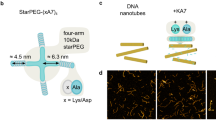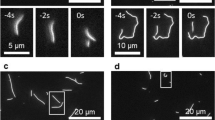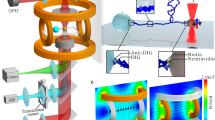Abstract
Filamentous structures are abundant in cells. Relatively rigid filaments, such as microtubules and actin, serve as intracellular scaffolds that support movement and force, and their mechanical properties are crucial to their function in the cell. Some aspects of the behaviour of DNA, meanwhile, depend critically on its flexibility—for example, DNA-binding proteins can induce sharp bends in the helix1. The mechanical characterization of such filaments has generally been conducted without controlling the filament shape, by the observation of thermal motions2,3,4,5 or of the response to external forces6,7,8,9 or flows10,11,12. Controlled buckling of a microtubule has been reported13, but the analysis of the buckled shape was complicated. Here we report the continuous control of the radius of curvature of a molecular strand by tying a knot in it, using optical tweezers to manipulate the strand's ends. We find that actin filaments break at the knot when the knot diameter falls below 0.4 µm. The pulling force at breakage is around 1 pN, two orders of magnitude smaller than the tensile stress of a straight filament. The flexural rigidity of the filament remained unchanged down to this diameter. We have also knotted a single DNA molecule, opening up the possibility of studying curvature-dependent interactions with associated proteins. We find that the knotted DNA is stronger than actin.
This is a preview of subscription content, access via your institution
Access options
Subscribe to this journal
Receive 51 print issues and online access
$199.00 per year
only $3.90 per issue
Buy this article
- Purchase on Springer Link
- Instant access to full article PDF
Prices may be subject to local taxes which are calculated during checkout




Similar content being viewed by others
References
Schultz, S. C., Shields, G. C. & Steitz, T. A. Crystal structure of a CAP-DNA complex: the DNA is bent by 90°. Science 253, 1001–1007 (1991).
Yanagida, M., Hiraoka, Y. & Katsura, I. Dynamic behaviors of DNA molecules in solution studied by fluorescence microscopy. Cold Spring Harbor Symp. Quant. Biol. 47, 177–187 (1983).
Yanagida, T., Nakase, M., Nishiyama, K. & Oosawa, F. Direct observation of motion of single F-actin filaments in the presence of myosin. Nature 307, 58–60 (1984).
Gittes, F., Mickey, B., Nettleton, J. & Howard, J. Flexural rigidity of microtubules and actin filaments measured from thermal fluctuations in shape. J. Cell Biol. 120, 923–934 (1993).
Yasuda, R., Miyata, H. & Kinosita, K. J Direct measurement of the torsional rigidity of single actin filaments. J. Mol. Biol. 263, 227–236 (1996).
Cluzel, P.et al. DNA: an extensible molecule. Science 271, 792–794 (1996).
Smith, S. B., Cui, Y. & Bustamante, C. Overstretching B-DNA: the elastic response of individual double-stranded and single-stranded DNA molecules. Science 271, 795–799 (1996).
Dupuis, D. E., Guilford, W. H., Wu, J. & Warshaw, D. M. Actin filament mechanics in the laser trap. J. Muscle Res. Cell Motil. 18, 17–30 (1997).
Tsuda, Y., Yasutake, H., Ishijima, A. & Yanagida, T. Torsional rigidity of single actin filaments and actin-actin bond breaking force under torsion measured directly by in vitro micromanipulation. Proc. Natl Acad. Sci. USA 93, 12937–12942 (1996).
Perkins, T. T., Quake, S. R., Smith, D. E. & Chu, S. Relaxation of a single DNA molecule observed by optical microscopy. Science 264, 822–826 (1994).
Bensimon, D., Simon, A. J., Croquette, V. & Bensimon, A. Stretching DNA with a receding meniscus: experiments and models. Phys. Rev. Lett. 74, 4754–4757 (1995).
Smith, D. E. & Chu, S. Response of flexible polymers to a sudden elongational flow. Science 281, 1335–1340 (1998).
Kurachi, M., Hoshi, M. & Tashiro, H. Buckling of a single microtubule by optical trapping forces: direct measurement of microtubule rigidity. Cell Motil. Cytoskel. 30, 221–228 (1995).
Miyata, H.et al. Mechanical measurements of single actomyosin motor force. Biophys. J. 68, 286S–290S (1995).
Landau, L. D. & Lifshitz, E. M. Theory of Elasticity 2nd edn(Pergamon, Oxford, (1970).
Oosawa, F., Fujime, S., Ishiwata, S. & Mihashi, K. Dynamic property of F-actin and thin filament. Cold Spring Harbor Symp. Quant. Biol. 37, 277–285 (1973).
Saitta, A. M., Soper, P. D., Wasserman, E. & Klein, M. L. Influence of a knot on the strength of a polymer strand. Nature 399, 46–48 (1999).
Nishizaka, T., Miyata, H., Yoshikawa, H., Ishiwata, S. & Kinosita, K. J Unbinding force of a single motor molecule of muscle measured using optical tweezers. Nature 377, 251–254 (1995).
Miyata, H., Yasuda, R. & Kinosita, K. J Strength and lifetime of the bond between actin and skeletal muscle α-actinin studied with an optical trapping technique. Biochim. Biophys. Acta 1290, 83–88 (1996).
Holmes, K. C., Popp, D., Gebhard, W. & Kabsch, W. Atomic model of the actin filament. Nature 347, 44–49 (1990).
Finer, J. T., Simmons, R. M. & Spudich, J. A. Single myosin molecule mechanics: piconewton forces and nanometre steps. Nature 368, 113–119 (1994).
Harada, Y.et al. Single-molecule imaging of RNA polymerase-DNA interactions in real time. Biophys. J. 76, 709–715 (1999).
Suzuki, N., Miyata, H., Ishiwata, S. & Kinosita, K. J Preparation of bead-tailed actin filaments: estimation of the torque produced by the sliding force in an in vitro motility assay. Biophys. J. 70, 401–408 (1996).
Yasuda, R., Noji, H., Kinosita, K. J & Yoshida, M. F1-ATPase is a highly efficient molecular motor that rotates with discrete 120° steps. Cell 93, 1117–1124 (1998).
Acknowledgements
We thank K. Adachi and Y. Hada for technical support and advice, S. Ishiwata for critically reading the manuscript, M. Hosoda for image processing, and H. Umezawa for laboratory management. This work was supported in part by Grants-in-Aid from Ministry of Education, Science, Sports and Culture of Japan, an Academic Frontier Promotional Project, and a Keio University Special Grant-in-Aid. R.Y. was a Research Fellow of the JSPS.
Author information
Authors and Affiliations
Rights and permissions
About this article
Cite this article
Arai, Y., Yasuda, R., Akashi, Ki. et al. Tying a molecular knot with optical tweezers. Nature 399, 446–448 (1999). https://doi.org/10.1038/20894
Received:
Accepted:
Issue Date:
DOI: https://doi.org/10.1038/20894
This article is cited by
-
Mechanical scission of a knotted polymer
Nature Chemistry (2024)
-
High capacity topological coding based on nested vortex knots and links
Nature Communications (2022)
-
The rate of microtubule breaking increases exponentially with curvature
Scientific Reports (2022)
-
819 molecular knot: a theoretical analysis of the electronic structure using an ONIOM approach
Journal of Molecular Modeling (2021)
-
Hydrodynamic inflation of ring polymers under shear
Communications Materials (2020)
Comments
By submitting a comment you agree to abide by our Terms and Community Guidelines. If you find something abusive or that does not comply with our terms or guidelines please flag it as inappropriate.



